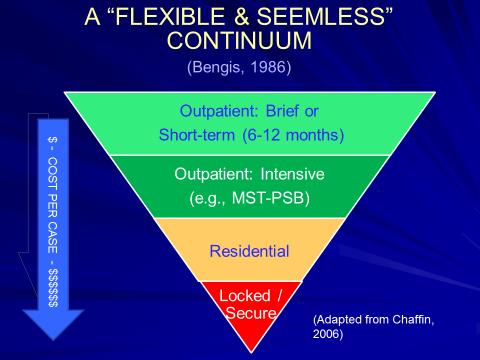Better lives,through better choices.
Level of Care & Placement
Professionals agree that youth should be placed in the lowest level of care appropriate which fits community, family, and individual treatment needs. Most youth with problematic sexual behaviors can remain in the community with safety planning and treatment in place. Level of care include outpatient, day treatment, or inpatient care. In some cases, youth would benefit from a lower level of care (outpatient) but there are no community based placement available (such as, foster care or relative homes). This results in youth being placed in residential care, a costly and often inappropriate match for the youth and treatment needs.
What are placement options to consider?
Placement options along a therapeutic or rehabilitative continuum include:
- Remaining at home
- With outpatient treatment
- With intensive home-based/community treatment such as Multisystemic Therapy
- Day treatment
- Placement with family or friends
- Supervised living situations foster care (consider evidence-based treatment foster care)
- Group homes
- Staff-secure residential treatment center
- Locked facilities that provide appropriate treatment, (e.g., Juvenile correctional facilities or psychiatric hospital settings)

Who decides where a youth is placed?
Actual placement determinations frequently are dependent on agency or system criteria. Entry to group homes, residential or hospital programs requires the youth to meet a set level of placement criteria; criteria that may vary by state or region. Juvenile justice involvement is dependent on legal charges, adjudications, and sentencing determinations.
Is it possible for youth to remain at home?
- Most youth with problematic sexual behavior are able to remain at home with sufficient parental support and supervision, even when there are younger children in the home.
- For youth who are unable to live at home while undergoing treatment, the next option considered often includes living with other family members or family friends in the community, but away from siblings and other children who are considered potentially vulnerable. When kinship placements are unavailable, child welfare agencies may consider foster care as an option.
What if siblings are in the home?
Special care should be taken when siblings or other children in the home have been involved in the problematic sexual behavior or are a teen’s victims. In these cases, the multidisciplinary team supporting the youth and family must consider sibling safety and wellbeing.
What if youth are deemed unsafe to remain in the community?
- When youth are considered unsafe to remain in the community due to the severity of their problematic sexual behaviors or other safety factors short-term residential treatment or hospitalization may be required.
- If placement is required, community reentry planning begins immediately and continues throughout placement.
- A small minority of youth may be placed in a “locked” treatment center or juvenile correctional facility.
- Involving the youth’s caretakers in treatment is imperative and must begin before the youth is discharged for ease of transition into family and community environments.
When does reunification begin?
At some point, based on the youth’s progress and individual and family assessments, caregivers and safety team members (Coming Soon) might determine that reunification is in the best interest of all involved. Reunification (Coming Soon) efforts should be well planned, involve sequential steps that include updated safety plans (Coming Soon), and occur under therapeutic supervision and guidance.
Clinical and case management decision-making regarding problematic sexual behavior interventions involve matching risk and needs with appropriate placement and treatment options.
For more information, relevant for matching youth with evidence-based treatment approaches and interventions,see Assessment (Coming Soon), Intervention (Coming Soon), and Resources.
